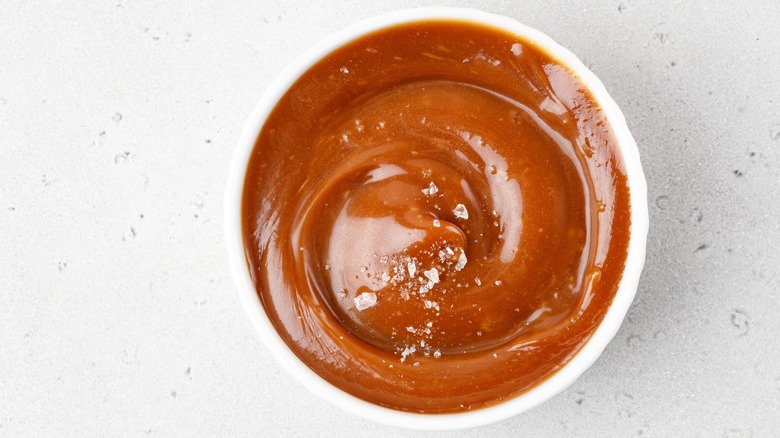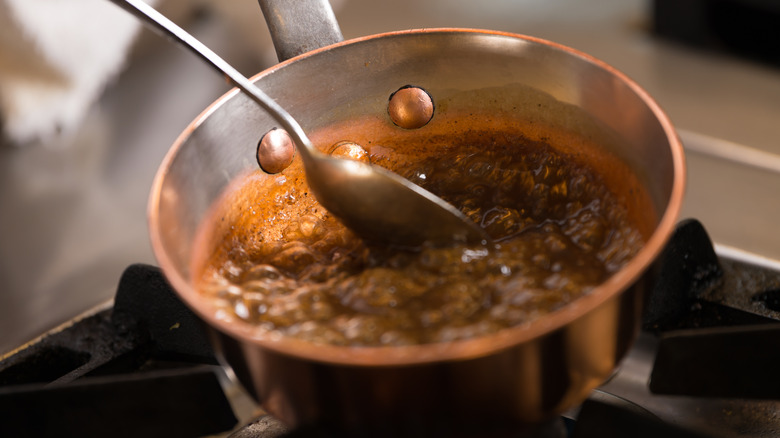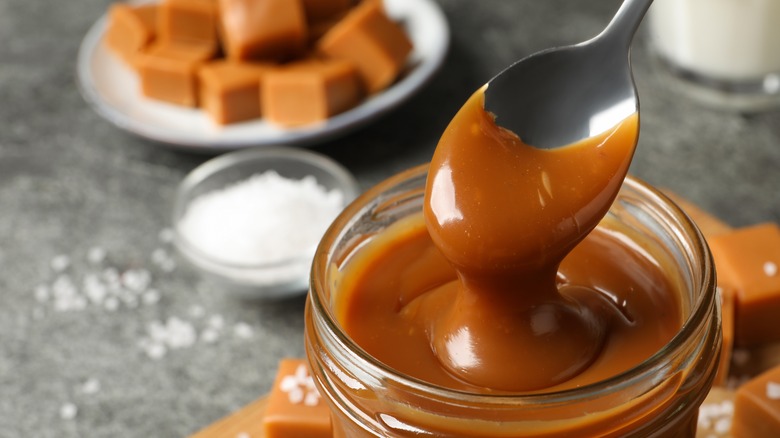The Science Behind Why You Need To Stop Stirring Homemade Caramel
One of the fussiest ingredients in all of cooking has to be homemade caramel. It's not challenging, or tricky — it's fussy. This isn't because it takes some masterful skills or a unique appliance, it is simply an ingredient that comes together easily until it doesn't.
The main two things that go wrong when making caramel are burning and crystallization. Caramel is essentially just cooked sugar, and so while it seems simple to keep it from burning, it can actually be a challenge. This is because different crystals can heat unevenly, break down too fast, and burn before all of the different crystals have had time to develop that signature flavor.
Crystallization is more complicated. Everyone already knows why something burns, but it's hard to explain why sugar can go from being crystallized, to creamy and smooth, then back to crystalized again. Luckily, once you understand why your sugar is turning back into crystals, you can prevent it, and turn this fussy mess into an old standard.
Don't stir the pot
Once your caramel is on the stove and boiling away, it can be tempting to stir it. You're worried about it burning, and maybe even more worried about cleaning up your pan later, so you give your caramel a stir to even out the heat. It makes sense to stir your pot, but you have to resist the urge. The reason that caramel turns back into sugar crystals and becomes grainy is because too much moisture has been lost in the cooking process.
When sugar is dissolved in water it loses its structure and becomes the liquid that develops into caramel. As you stir your caramel though, too much of the water will splash up onto the sides of the pot, and leave your caramel to turn grainy and crystallized instead.
If you choose to make a dry caramel that consists entirely of sugar, it helps to use a large shallow pan, and leave your sugar alone. It can help to brush it from side to side gently with a spatula to distribute some of the heat, but otherwise, it should be left alone. Using medium heat on a more shallow pan will also allow the heat to distribute more evenly and prevent burning. Just be sure to keep an eye on the caramel as it starts to develop its darker hues.
How to prevent caramel from crystallizing
If you're making a wet caramel (a mixture of water and sugar), and you notice that things are starting to turn grainy, there are a few things you can do to stop the crystallization process.
Even if you've been good and haven't been stirring, there's a chance that too much water has cooked off in the process. One way to handle this is to put a lid on your caramel for a few minutes . Doing this allows the evaporating moisture to condense on the lid and be reincorporated into the caramel.
Crystallization is also odd because it can spread like a bad cold. To prevent this it's important that any crystals that do develop on the side of the pot during cooking are brushed away. By brushing these crystals with a wet pastry brush, you should be able to turn them back into a liquid before they can cause more crystallization.
If you're really worried about crystallization, you can also add an acid like lemon juice into your caramel. This will turn the abundant sucrose molecules into a mixture of fructose and glucose which will not crystallize as easily.
Caramel is fussy, but absolutely worth making on your own. It's an ingredient that's worth mastering thanks to its versatile uses and complex flavor.


